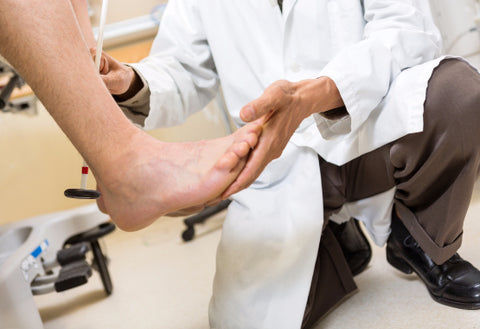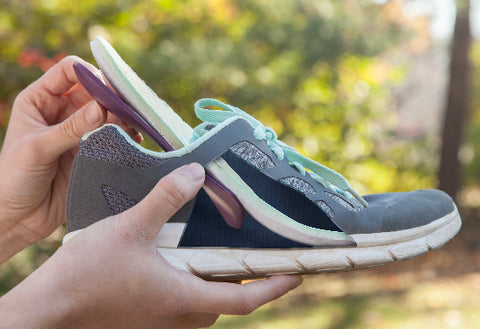
"Could a pair of orthotics really relieve my discomfort?". This is one of the most common questions asked by people with flat feet. Unfortunately, a simple "yes" or "no" answer is often difficult to give in this situation. Many factors can determine if orthotics can relieve the symptoms associated with flat feet, such as arch and heel pain. It is first important to understand what "flat feet" are, and what is the root cause of the discomfort associated with them.
What Are Flat Feet?
Flat feet are often referred to as "fallen arches", and is a common condition seen in both children and adults. The arch of the foot is formed by a group of tendons and ligaments attached to the heel and foot bones. Tendons in the lower leg and foot must work in conjunction, pulling at the correct times during standing and walking. This aids in forming the arch of the foot. If the tendons do not pull sufficiently enough, or the ligaments of the foot are lax, the foot may be left with a very low arch, or no arch at all. This condition is commonly referred to as flat feet.
This lack of internal arch support can cause a variety of problematic complications. In people with flat feet, the standard pressure of gait (walking), or standing, must shift to other portions of the feet that are not designed to handle this type of strain. If left untreated this can cause pain, discomfort, and possibly joint and soft tissue injury.

Causes Of Flat Feet
Flat feet can be attributed to many causes. They may be present in newborns, develop during childhood, or slowly progress as an adult. Frequently, their is a hereditary component. Other possible causes of progressive flat feet include:
- Long periods of time walking or standing in high heeled shoes
- Using shoes with poor arch support
- Over-stretched, or possibly torn, tendons and ligaments
- History of fracture or dislocation of the foot bones
- Muscle damage caused by excessive strain on the feet (This may be caused by obesity, trauma, etc.)
- Abnormality at birth
- Nerve conditions and abnormalities
- Certain health conditions, such as rheumatoid arthritis and muscular dystrophy
The risks of developing progressive chronic flat feet can also increase with obesity, pregnancy, diabetes, and aging.

Symptoms Of Flat Feet
It is very common for individuals with flat feet to experience discomfort, and sometimes significant pain. This is most commonly manifested as heel pain and arch pain. This may radiate to the ball of the foot as well.
Activities such as prolonged standing and walking may be uncomfortable for a person suffering from collapsed arches. There is commonly significant strain on other portions of the foot , as well as restrained proper foot movement. Flat feet have long been suspected in contributing to foot and ankle arthritis, as well as leg, hip and back pain.
Relief From Flat Feet
The treatments for flat feet range from conservative to surgical, and are often dependent on the severity of the symptoms and underlying cause. In many cases, the symptoms of flat feet can be controlled effectively with conservative, non surgical care. If your doctor confirms the diagnosis of flat feet, they may suggest some of the following:
- Purchasing appropriate shoes that stabilize the heel bone and support the arch of the foot. Be aware that your new shoes should be able to accomodate an orthotic device if one were eventually prescribed for you by your podiatrist. A quality running shoe with a removable insole/liner will often be adequate.
- Using custom-made or over the counter orthotics to control the flattening of the arch while standing, walking and running.
- Regular strengthening and stretching exercises under the supervision of a professional
- Physical therapy
- Ice and/or compression to reduce pain and swelling
- Anti-inflammatory or pain medications

How Do I Pick the Right Over the Counter Orthotic for Flat Feet?
- It is important to choose an orthotic that is not too rigid. When force is applied to an overly rigid device, the design of the insole or its material may not compress adequately. This transmits the shock generated from your foot striking the ground into the joints of your body. This will commonly lead to ankle, knee and back discomfort.
- Don't pick an orthotic that is too "cushiony". A flimsy or squishy orthotic may be comfortable at first, but devices such as these often fail to provide adequate support for the arches of the feet. They often are not effective in alleviating the symptoms caused by flat feet.
- For many years it has been a common practice for over the counter orthotics to be sold by "approximate sizing". This can lead to poor support, and an inadequate fit, for many users. Many people may be "in between" sizes for the large majority of insoles on the market, leading them to believe that an over the counter orthotic may not be effective for them. Therefore, it is imperative to confirm that any orthotic you purchase fits your foot and arch appropriately, regardless of the manufactures' suggested sizing.
- Podiatrists can often fabricate a custom orthotic that is specifically designed for your foot and your condition. They can also aid you in selecting an over the counter orthotic if that is appropriate for your condition.
Regardless of the orthotics you may ultimately choose, it is generally important to "break in" these types of devices over a prolonged period of time. The foot may not be accustomed to the level of support an orthotic provides, and it may take some time for the muscles and ligaments to acclimate. Check out our homepage for more information about over the counter orthotics for the relief of symptoms associated with flat feet.



